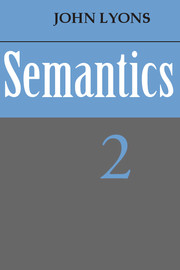Book contents
- Frontmatter
- Contents
- Figures
- Typographical conventions
- Preface
- 10 Semantics and grammar I
- 11 Semantics and grammar II
- 12 Semantics and grammar III
- 13 The Lexicon
- 14 Context, style and culture
- 15 Deixis, space and time
- 16 Mood and illocutionary force
- 17 Modality
- Bibliography
- Index of subjects
- Index of personal names
13 - The Lexicon
Published online by Cambridge University Press: 05 June 2012
- Frontmatter
- Contents
- Figures
- Typographical conventions
- Preface
- 10 Semantics and grammar I
- 11 Semantics and grammar II
- 12 Semantics and grammar III
- 13 The Lexicon
- 14 Context, style and culture
- 15 Deixis, space and time
- 16 Mood and illocutionary force
- 17 Modality
- Bibliography
- Index of subjects
- Index of personal names
Summary
Lexical entries
Conventional dictionaries are essentially lists of what might be called lexical entries. Each of these entries is introduced by a head-word in its standard orthographic representation; and the lexical entries are alphabetized in terms of their head-word. Alphabetization is of course no more than a technique for listing the entries according to a conveniently applicable, but theoretically irrelevant, principle. The conventional dictionary can, for our purposes, be thought of as an unordered set of lexical entries, each of which is indexed by means of its head-word.
The fact that the head-word is represented orthographically (and may or may not be furnished with a phonetic or phonological transcription) is something that will not concern us here. We should not forget, however, as linguists, that most adult native speakers of English are accustomed to thinking of word-forms as relatively stable written entities whose pronunciation may be somewhat variable. Homonymy, to which we will return presently, is traditionally based upon orthographic type-token identity (cf. 13.4); and this is something that the lexicographer cannot but be concerned with, since the organization of the conventional dictionary depends upon it. Faced with the fact that the noun ‘bank’ (whose written forms are bank, banks, bank's and banks') has several different meanings, he must decide how many lexical entries (all indexed by the head-word bank) he will put into his dictionary.
- Type
- Chapter
- Information
- Semantics , pp. 512 - 569Publisher: Cambridge University PressPrint publication year: 1977



